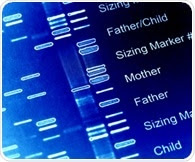| |  Using genetic testing to inform which blood thinner to use following a procedure to open narrowed blood vessels resulted in significantly fewer complications among patients, according to new research in Circulation: Genomic and Precision Medicine, an American Heart Association journal. Using genetic testing to inform which blood thinner to use following a procedure to open narrowed blood vessels resulted in significantly fewer complications among patients, according to new research in Circulation: Genomic and Precision Medicine, an American Heart Association journal. | |
|
| |  A new study has definitively shown that a single treatment with gene therapy using adeno-associated viral (AAV) vector gene delivery to replace the defective gene responsible for congenital adrenal hyperplasia (CAH) will only temporarily alleviate the hereditary disorder. A new study has definitively shown that a single treatment with gene therapy using adeno-associated viral (AAV) vector gene delivery to replace the defective gene responsible for congenital adrenal hyperplasia (CAH) will only temporarily alleviate the hereditary disorder. | |
|
| |  Recent advances in CRISPR-Cas13 technology mean that it can now be used to locate and even reduce cancer associated gene expression. Recent advances in CRISPR-Cas13 technology mean that it can now be used to locate and even reduce cancer associated gene expression. | |
|
| |  Drug resistance is a major obstacle to effective treatment for patients with cancer and leukemia. Epigenetic modifying drugs have been proven effective for some patients with hematologic malignancies, such as myelodysplastic syndrome (MDS) and acute myeloid leukemia (AML). Drug resistance is a major obstacle to effective treatment for patients with cancer and leukemia. Epigenetic modifying drugs have been proven effective for some patients with hematologic malignancies, such as myelodysplastic syndrome (MDS) and acute myeloid leukemia (AML). | |
|
| |  Rare genetic mutations associated with impairment of the breathing muscles are more common in children who have died from sudden infant death syndrome (also known as ‘cot death’) than in healthy controls, suggesting a possible genetic element of the disorder, according to a case-control study in the UK and USA published in The Lancet. Rare genetic mutations associated with impairment of the breathing muscles are more common in children who have died from sudden infant death syndrome (also known as ‘cot death’) than in healthy controls, suggesting a possible genetic element of the disorder, according to a case-control study in the UK and USA published in The Lancet. | |
|
| |  Scientists have converted CRISPR/Cas9 into a genome surveillance tool, in an effort to develop a more effective way of fighting disease. Scientists have converted CRISPR/Cas9 into a genome surveillance tool, in an effort to develop a more effective way of fighting disease. | |
|
| |  Researchers have developed a new model that can predict the effect of rare genetic variants on a person’s IQ. Researchers have developed a new model that can predict the effect of rare genetic variants on a person’s IQ. | |
|
| |  Researchers have developed a new model that can predict the effect of rare genetic variants on a person’s IQ. Researchers have developed a new model that can predict the effect of rare genetic variants on a person’s IQ. | |
|
| |  Cot death or Sudden Infant Death Syndrome (SIDS) is a rare but unexplained and tragic occurrence where babies between ages two and four months who are apparently healthy die unexpectedly during sleep. SIDS is responsible for around 300 and 2400 deaths in the United Kingdom and United States of America yearly. Researchers have now found a genetic link that could explain the occurrence and risk of such incidents. Cot death or Sudden Infant Death Syndrome (SIDS) is a rare but unexplained and tragic occurrence where babies between ages two and four months who are apparently healthy die unexpectedly during sleep. SIDS is responsible for around 300 and 2400 deaths in the United Kingdom and United States of America yearly. Researchers have now found a genetic link that could explain the occurrence and risk of such incidents. | |
|
| |  A group of researchers at Osaka University reported the function of GTSF1 in male germ cells. The study, which can be read in EMBO Reports, shows that GTSF1 is an essential factor for secondary piRNA biogenesis by regulating piRNA-mediated cleavage of target RNA. A group of researchers at Osaka University reported the function of GTSF1 in male germ cells. The study, which can be read in EMBO Reports, shows that GTSF1 is an essential factor for secondary piRNA biogenesis by regulating piRNA-mediated cleavage of target RNA. | |
|
| |  A genetic mutation that may protect people from malaria, but was thought to be rare, is surprisingly common, suggest the findings of a new study led by scientists at The Scripps Research Institute. A genetic mutation that may protect people from malaria, but was thought to be rare, is surprisingly common, suggest the findings of a new study led by scientists at The Scripps Research Institute. | |
|
| |  Scientists have found a genetic trigger that may improve the brain's ability to heal from a range of debilitating conditions, from strokes to concussions and spinal cord injuries. Scientists have found a genetic trigger that may improve the brain's ability to heal from a range of debilitating conditions, from strokes to concussions and spinal cord injuries. | |
|
| |  Genetically engineered human T cells that are effective at fighting liver cancer in mice may one day help patients fight liver cancer, say researchers. Genetically engineered human T cells that are effective at fighting liver cancer in mice may one day help patients fight liver cancer, say researchers. | |
|
| |  Researchers have discovered a genetic trigger that may improve the brain’s ability to heal in conditions such as stroke, concussion and spinal cord injury. Researchers have discovered a genetic trigger that may improve the brain’s ability to heal in conditions such as stroke, concussion and spinal cord injury. | |
|
| |  Most of the human genome - 98 percent - is made up of DNA but doesn't actually encode genes, the recipes cells use to build proteins. Most of the human genome - 98 percent - is made up of DNA but doesn't actually encode genes, the recipes cells use to build proteins. | |
|
| |  Retroposons are repetitive DNA fragments that are inserted into a host chromosome after reverse transcription from an RNA molecule. Retroposons are repetitive DNA fragments that are inserted into a host chromosome after reverse transcription from an RNA molecule. | |
|
| |  EPFL biologists and geneticists have uncovered how the circadian clock orchestrates the 24-hour cycle of gene expression by regulating the structure of chromatin, the tightly wound DNA-protein complex of the cell. The work is published in Genes & Development. EPFL biologists and geneticists have uncovered how the circadian clock orchestrates the 24-hour cycle of gene expression by regulating the structure of chromatin, the tightly wound DNA-protein complex of the cell. The work is published in Genes & Development. | |
|
| |  Fluorescence in situ hybridization (FISH) is a genetic technique used to diagnose congenital diseases, infectious disease and cancer. Fluorescence in situ hybridization (FISH) is a genetic technique used to diagnose congenital diseases, infectious disease and cancer. | |
|
| |  Amniocentesis is a diagnostic procedure in which a small amount of amniotic fluid is removed from the sac of amniotic fluid around the baby inside the uterus, to test for certain chromosomal anomalies and other genetic defects. This fluid is meant to protect and nourish the baby and is vital for its proper development. Amniocentesis is a diagnostic procedure in which a small amount of amniotic fluid is removed from the sac of amniotic fluid around the baby inside the uterus, to test for certain chromosomal anomalies and other genetic defects. This fluid is meant to protect and nourish the baby and is vital for its proper development. | |
|
| |  An international team of researchers led by Lucio Miele, MD, PhD, Professor and Chair of Genetics at LSU Health New Orleans School of Medicine, and Justin Stebbing, BM BCh MA, PhD, Professor of Cancer Medicine and Medical Oncology at Imperial College of Medicine in London, has found new genetic mutations that promote the survival of cancer cells. An international team of researchers led by Lucio Miele, MD, PhD, Professor and Chair of Genetics at LSU Health New Orleans School of Medicine, and Justin Stebbing, BM BCh MA, PhD, Professor of Cancer Medicine and Medical Oncology at Imperial College of Medicine in London, has found new genetic mutations that promote the survival of cancer cells. | |
|
| |  An international team led by Dr. Patricia Dahia, M.D., Ph.D., of UT Health San Antonio, discovered a genetic mutation that explains why adults with severe congenital heart defects--who live with low oxygen in their blood--are at dramatically high risk for adrenal gland cancer. An international team led by Dr. Patricia Dahia, M.D., Ph.D., of UT Health San Antonio, discovered a genetic mutation that explains why adults with severe congenital heart defects--who live with low oxygen in their blood--are at dramatically high risk for adrenal gland cancer. | |
|
| |  Leber congenital amaurosis (LCA) is a very severe form of congenital blindness due to hereditary retinal dystrophy. It was first identified by Theodore Leber in 1869, and is diagnosed early in infancy or at birth. Leber congenital amaurosis (LCA) is a very severe form of congenital blindness due to hereditary retinal dystrophy. It was first identified by Theodore Leber in 1869, and is diagnosed early in infancy or at birth. | |
|
| |  Modern neuroscience, for all its complexity, can trace its roots directly to a series of pen-and-paper sketches rendered by Nobel laureate Santiago Ramón y Cajal in the late 19th and early 20th centuries. Modern neuroscience, for all its complexity, can trace its roots directly to a series of pen-and-paper sketches rendered by Nobel laureate Santiago Ramón y Cajal in the late 19th and early 20th centuries. | |
|
| |  The disease mechanism for adult-onset progressive degenerative diseases begins much earlier than previously thought, according to a Northwestern Medicine study published in the Journal of Clinical Investigation. The disease mechanism for adult-onset progressive degenerative diseases begins much earlier than previously thought, according to a Northwestern Medicine study published in the Journal of Clinical Investigation. | |
|
| |  Gluten is a family of proteins that make up about 85% to 90% of the protein composition found in wheat, barley, rye and some other grains. It is made up of almost equal proportions of two types of proteins called gliadins and glutenins, of which each has many subtypes. Thus, the genetic diversity of gluten is staggering. Gluten is a family of proteins that make up about 85% to 90% of the protein composition found in wheat, barley, rye and some other grains. It is made up of almost equal proportions of two types of proteins called gliadins and glutenins, of which each has many subtypes. Thus, the genetic diversity of gluten is staggering. | |
|
| |  An echogenic intracardiac focus is a small bright spot seen within the region of the heart seen during an ultrasound examination. An echogenic intracardiac focus is a small bright spot seen within the region of the heart seen during an ultrasound examination. | |
|
| |  Leber congenital amaurosis (LCA) is a congenital cause of severe visual loss. It is an autosomal recessive condition caused by several different mutations in a variety of genes. It is therefore important to identify the cause of the retinopathy using clinical findings and other diagnostic tests to support the diagnosis. Genetic testing has become mandatory to establish the diagnosis. Leber congenital amaurosis (LCA) is a congenital cause of severe visual loss. It is an autosomal recessive condition caused by several different mutations in a variety of genes. It is therefore important to identify the cause of the retinopathy using clinical findings and other diagnostic tests to support the diagnosis. Genetic testing has become mandatory to establish the diagnosis. | |
|
| |  Bodo saltans virus, the first isolated representative of the most abundant giant viruses in the sea, has been unveiled by researchers at the University of British Columbia. Bodo saltans virus, the first isolated representative of the most abundant giant viruses in the sea, has been unveiled by researchers at the University of British Columbia. | |
|
| |  The condition called Leber Congenital Amaurosis (LCA) is an inherited one, caused by the transmission of two copies of a defective or mutated gene, one from each parent, which results in abnormal retinal development and significant or total impairment of its function. The loss of vision results in visual acuity of 20/400 or less. The condition called Leber Congenital Amaurosis (LCA) is an inherited one, caused by the transmission of two copies of a defective or mutated gene, one from each parent, which results in abnormal retinal development and significant or total impairment of its function. The loss of vision results in visual acuity of 20/400 or less. | |
|
| |  P53, the gene product of the TP53 gene, is a fundamental protein involved in the suppression of tumorigenesis. P53, the gene product of the TP53 gene, is a fundamental protein involved in the suppression of tumorigenesis. | |
|
| |  CAR T cells are T lymphocytes that have been genetically engineered to express a chimeric antigen receptor that is specific to a tumor antigen. CAR T cells are T lymphocytes that have been genetically engineered to express a chimeric antigen receptor that is specific to a tumor antigen. | |
|
| |  AMSBIO has signed an agreement with Genea Biocells (San Diego, USA) to become global distribution partner to the academic community for its groundbreaking skeletal muscle differentiation product range. AMSBIO has signed an agreement with Genea Biocells (San Diego, USA) to become global distribution partner to the academic community for its groundbreaking skeletal muscle differentiation product range. | |
|
| |  The impact of nutrition and lifestyle on cardiovascular health will be key elements discussed by health professionals during EuroPrevent 2018 in Ljubljana, Slovenia, in April. EuroPrevent is the annual congress of the European Association of Preventive Cardiology, a branch of the European Society of Cardiology. The impact of nutrition and lifestyle on cardiovascular health will be key elements discussed by health professionals during EuroPrevent 2018 in Ljubljana, Slovenia, in April. EuroPrevent is the annual congress of the European Association of Preventive Cardiology, a branch of the European Society of Cardiology. | |
|
| |  The frequency of alpha brain waves can be used as a measure of an individual's vulnerability to developing and experiencing pain, researchers at the University of Birmingham in the UK and University of Maryland in the US have discovered. The frequency of alpha brain waves can be used as a measure of an individual's vulnerability to developing and experiencing pain, researchers at the University of Birmingham in the UK and University of Maryland in the US have discovered. | |
|
| |  After nearly 400 confirmed infections and 100 deaths, the spread of Lassa fever in Nigeria is beginning to slow but the epidemic is far from contained, the World Health Organization and the Nigeria Centre for Disease Control have warned. After nearly 400 confirmed infections and 100 deaths, the spread of Lassa fever in Nigeria is beginning to slow but the epidemic is far from contained, the World Health Organization and the Nigeria Centre for Disease Control have warned. | |
|
| |  Professor Jack Gilbert gives an overview of the Burglary Microbiome Project, which he discussed at Pittcon 2018. Professor Jack Gilbert gives an overview of the Burglary Microbiome Project, which he discussed at Pittcon 2018. | |
|
| |  Wistar researchers have found rationale for repurposing a class of antitumor compounds called HDAC inhibitors, already approved by the FDA for the treatment of diseases such as leukemia, as a new therapeutic option for ovarian cancer with mutations in the ARID1A gene. Wistar researchers have found rationale for repurposing a class of antitumor compounds called HDAC inhibitors, already approved by the FDA for the treatment of diseases such as leukemia, as a new therapeutic option for ovarian cancer with mutations in the ARID1A gene. | |
|
| |  Fibers produced using bioactive glasses exhibit bactericidal properties, meaning they can be used to reduce the risk of a wound becoming infected. Fibers produced using bioactive glasses exhibit bactericidal properties, meaning they can be used to reduce the risk of a wound becoming infected. | |













































































No hay comentarios:
Publicar un comentario